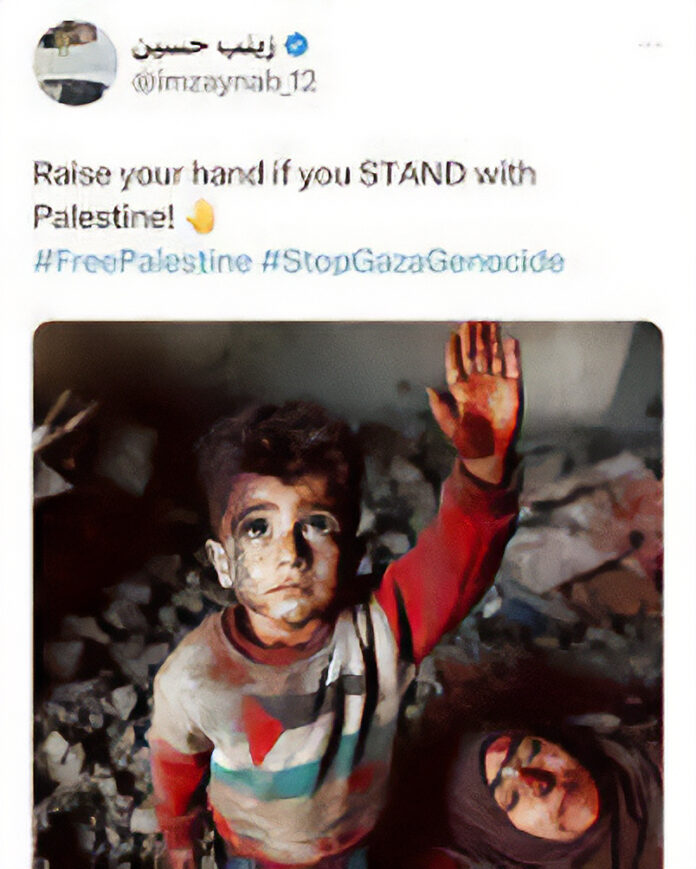The heart-rending photo shows a Gazan man holding a child, with four other children clinging to his back, their arms around his neck.
The man’s shoulder, though, seems grotesquely disjointed. And the children seem to have either too many or too few fingers and toes.
The image, which garnered tens of thousands of views on X, is a fake. The weird shoulder and hands are all the evidence one needs—if one knows what to look for—to spot a digital (in both the word’s senses) fakery.
Likewise counterfeit are countless other images of the current conflict, including bombed-out Gazan homes, ravaged streets and bloodied infants and children.
Examined closely, strangely deformed fingers or odd-looking eyes offer tips that an image was generated artificially. But improved technology has made some of the imaginary images very hard to identify as such.
When I wrote about “deepfakes”—manufactured photos or videos depicting scenes that aren’t real or people saying things they never said—in these pages back in the summer of 2022, my main concern was how Artificial Intelligence-created images and videos could be weaponized for political purposes. There were, even then, AI-generated fake videos featuring former President Obama and a seemingly inebriated former House Speaker Nancy Pelosi. At the time, the potential for deepfakes fostering anti-Israel and anti-Semitic sentiments was not at the forefront of my mind.
It should have been.
There is no doubt that Gazan civilians have been wounded or killed during Israel’s post-October 7 invasion of the territory. Tragically, the wages of war, even righteous war, always involve casualties among innocents, even large numbers of them (See Dresden and Hiroshima and Nagasaki, for only some World War II examples). And civilians in Gaza have been and are in particular peril, considering Hamas’ cleverly immoral tactic of entrenching its weaponry and terrorists among civilians and in structures like private homes, schools, hospitals and mosques.
And so, if the bloodthirsty terrorists in Gaza are to be vanquished, the deaths of innocents are as inevitable as they are tragic. Their blood is ultimately on the already saturated hands of Hamas.
But visuals have a special ability to amplify scenes of suffering and move hearts and minds. And they are no less compelling for being fake. The caption on the manufactured image of the strange-shouldered Gazan man and the multifingered children hanging from him, which is accompanied by a Palestinian flag and a broken heart emoji, reads: “A picture is worth a thousand words.”
A fake one is worth even more, at least if measured in the anger and hatred it can generate. Those kids with the digital digits may be fake, but the outrage stoked by the image in which they appear is all too real.
If you’ve seen a photo of a young child, silhouetted from behind as he looks out at the huge cloud caused by an explosion in the distance, you’ve been deepfaked. If you saw any of a group of photos of Israeli flags—all waving in different directions—lining a road amid the ostensible rubble of a Gazan town, you’ve been deepfaked. If you have been greeted with the up-close face of a “Gazan child” shrieking in terror but whose skin seems to have been somehow plasticized, you’ve been—well, you know what.
Anyone with the nasty habit of following social media has likely seen a wealth of images labeled as originating in Gaza. Some are surely real, but some are just as surely not.
The problem, though, even for those who shun social media, is that there are millions upon millions who do not, who trust whatever they see on their screens or phones. And who lack the skills—or the will—to try to discern which images—or “reports,” for that matter—are actual and which are imaginary.
What’s more, and even more disturbing, is that there have been traditional media that have picked up and featured fake imagery. Even some people who are sufficiently savvy to discount what they see on unregulated social media will not doubt what they see in a print medium or an Internet news website, never suspecting that the paper or site may itself have fallen for a fakery.
In some cases, photos or video clips have not been artificially generated, but rather “borrowed” from other conflicts or disasters and passed off as coming from Gaza. That adds a different sort of fuel to the fakery fire.
Nothing hits the heart like a crying, bloodied baby or child. Propagandists, knowing that fact well, make special efforts to create such images. Imran Ahmed, CEO of the Center for Countering Digital Hate, a nonprofit that has tracked disinformation from the war, contends, entirely reasonably, that the more abhorrent the image, the more likely its viewer is to remember it and to share it with others, spreading the fakery even further.
And then, further compounding the propaganda problem, are photo repositories that offer stock photos, like Adobe Stock Images or iStock, which is owned by Getty Images.
Getty Images itself vets its editorial photographers to ensure that they have the requisite credentials. But stock image sites, including its own, let anyone upload anything they wish, as long as the uploader owns the rights to the image. And producers of fake photos, of course, own their work.
Stock images are not meant to be used by news organizations. They are intended, even the photographs among them, to serve as a kind of caricature, for illustrative purposes. Adobe Stock Images is currently selling AI-generated images showing fake scenes depicting bombardment of cities in both Gaza and Israel. Such images are supposed to be labeled as such, and usually are.
But less-than-responsible individuals, and even some news organizations, perhaps in a rush looking to “scoop” other media, have at times grabbed a “perfect” photographic image to accompany a post or story, even if that image is fake.
The 24-hour news cycle and expansion of social media platforms intensify the evil. “A lie,” as the saying attributed to Mark Twain goes, “can travel halfway around the world while the truth is still putting on its shoes.” Today, it’s gone all the way around the world before truth even finds its shoes. Or the closet.
And that’s true about an image no less than a lie. Groucho Marx’s challenge—“Who ya gonna believe, me or your own eyes?”—needs updating. One’s own eyes are themselves no longer trustworthy. What they rest upon is all too often not a slice of reality but some stranger’s fantasy.
Critical media literacy—knowing how to spot deepfakes and how to do reverse image searches to investigate photographs—offers the best promise for addressing the problem of false images. But the masses, just as they readily fall into the trap of fake news, go headfirst into the pit of fake photos.
And that yields much ugliness, like the angry “pro-Palestinian” demonstrations and near-riots that we’ve seen of late.
Those bloodied children, after all, even if they have seven fingers on one hand and three on the other, just can’t be ignored.
To read more, subscribe to Ami





















